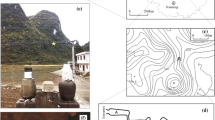Abstract
The studies of the oxgen and carbon isotopes of the rainwater in Guilin area, the drip water and the present carbonate deposit in Panlong cave of Guilin show that: (i) as to the general characteristics of the oxygen isotopes of the rainwater within a year and between years, the δ18O values decrease with an increase of air temperature and the rainfall, and the correlation between δ18O values and the mean monthly air temperature is much better than that between δ18O values and the rainfall, and the δ18O values of the rainwater during the summer monsoon are much smaller than those during winter monsoon; (ii) δ18O values of the drip water have a quite good correlation with the δ18O values of the rainwater in the same period; (iii) when the conditions are appropriate, δ13C can be used as an environmental proxy, that is, the smaller δ13C of speleothems is, the larger the proportion of C3 plants is and the more plentiful the rainfall is. On the contrary, C4plants may be prevailing or the environment may be a stony desert caused by climate changes or human activity.
Similar content being viewed by others
References
O’Neil, J. R., Clayton, R.N., Mayeda, T. K., Oxygen isotope fractionation in divalent metal carbonates, Journal of Chemical Physics, 1969, 51: 5547.
Hendy, C. H., The isotopic geochemistry of speleothems—Pt. I. the calculation of the effects of different model of formation on the isotopic composition of speleothems and their applicability as paleoclimate indicators, Geochim. et Cosmochim Acta, 1971, 35: 801.
Gascoyne, M., Paleoclimate determination from cave calcite deposits, Quaternary Science Reviews, 1992, 11: 609.
Li, B., Yuan, D., Qin, J. et al., A high resolution record of climate change in a stalagmite from Panlong cave of Guilin since 36 000 years B.P., in Karst Waters Institute Special Publication 2: Climate Change: The Karst Record, Charles Town: Karst Waters Institute, Inc., 1996, 93–96.
Bar-Mattews, M., Ayalon, A., Late Quaternary Paleoclimate in the Eastern Mediterranean Region from stable isolope analysis of speleothems at Soreg Cave, Israel, Quaternary Research, 1997, 47: 155.
Tan, M., Liu, T., Zhong, H. et al., Preliminary study of the paleoclimatic information of the stable isotopes of the Holocene speleothems under the monsoon, Chinese Science Bulletin, 1997, 42: 1302.
Baker, A., Smart, P. L., Edwards, R. L. et al., Annual growth banding in a cave stalagmite, Nature, 1993, 364: 518.
Coplen, T. B., Winograd, I. J., Landwehr, J. M. et al., 500 000-year stable carbon isotopic record from Devils Hole, Nevada, Science, 1994, 263: 361.
Holmgren, K., Karlen, W., Palaeoclimate significance of the stable isotopic composition and petrology of a late Pleistocene stalagmite from Botswana, Quaternary Research, 1995, 43: 320.
Szabo, B. J., Bush, C.A., Uranium-series dating of carbonate (tufa) deposits associated with Quaternary fluctuations of Pyramid lake, Nevada, Quaternary Research, 1996, 45: 271.
Talma, A. S., Vogel, J.C., Late Quaternary paleotemperature derived from a speleothem from Caugo caves, Cape Province, South Africa, Quaternary Research, 1992, 37: 203.
Winograd, I. J., Coplen, T. B., Landwehr, J. M. et al., Continuous 50 000-year climate record from vein calcite in Devils Hole, Nevada, Science, 1992, 258: 255.
Liu, D., Chen, Z., Luo, K., A study on hydrogen and oxygen isotopic composition of precipitation in Guilin area, Carsolgica Sinica (in Chinese with English abstract), 1987, 6(1): 225.
Editorial Board of Academia Sinica for “Physical Geography of China”, Physical Geography of China—Climate (in Chinese), Beijng: Science Press, 1984, 1–11.
Friedman, I., O’Neil, J. R., Compilation of stable isotope fractionation factors of geochemical interest, in Data of Geochemistry Sixth Edition (ed. Fleischer, M.), Washington DC: Geological Survey Professional Paper 440-KK, 1977, KK1-KK111.
Cerling, T. E., The stable isotope composition of modern soil carbonate and its relationship to climate, Earth and Planetary Science Letters, 1984, 71: 229.
Author information
Authors and Affiliations
Corresponding author
Rights and permissions
About this article
Cite this article
Li, B., Yuan, D., Qin, J. et al. Oxygen and carbon isotopic characteristics of rainwater, drip water and present speleothems in a cave in Guilin area, and their environmental meanings. Sci. China Ser. D-Earth Sci. 43, 277–285 (2000). https://doi.org/10.1007/BF02906823
Received:
Issue Date:
DOI: https://doi.org/10.1007/BF02906823




